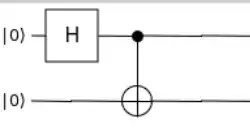Entangled quantum particles are very interesting as they only make sense if you look only at the math.
Usually, when we talk of "entangling" two qubits, we mean that we have two qubits, $A$ and $B$, both initialized in the $| 0 \rangle$ state. We then run this circuit on them:
This puts the system into the state $\frac{1}{\sqrt2} | 00 \rangle + \frac{1}{\sqrt2} | 11 \rangle$.
This circuit only works when the two qubits can be used together in a single circuit. Is there any way to entangle two qubits together (like this) at a distance? I guess it may require having a quantum circuit able to work between distant qubits; something that may be impossible.
